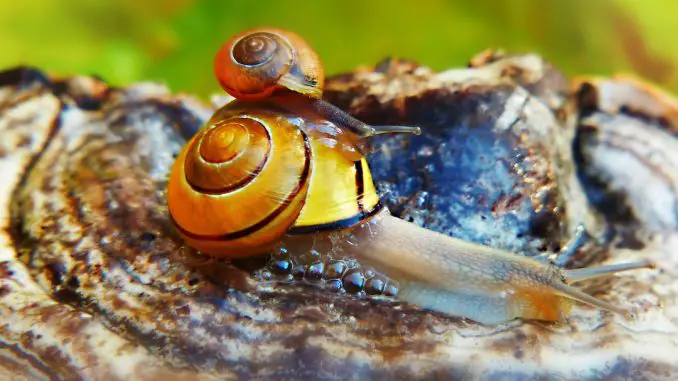
Have you ever wondered if snails mate in a fish tank? It’s not an uncommon question for pet fish keepers and enthusiasts to ask, as many want to make sure their tanks are healthy and safe for all the inhabitants. Snails can be great additions to your aquarium ecosystem but it’s important that we understand how they live before introducing them into our tanks. In this blog post, we’ll explore the different types of snails, learn about their mating habits, and discuss what needs to be taken into consideration when keeping snails in a fish tank – so let’s dive right in. Do snails mate in a fish tank? We’re here with answers.
Table of Contents:
Types of Snails
Freshwater Snails:
Freshwater snails are one of the most common types of snails found in fish tanks. They can be identified by their soft, slimy shells and long antennae. These snails feed on algae, decaying plant matter, and other organic debris that accumulates in aquariums. Some species of freshwater snail can reproduce quickly if given the right conditions, so it is important to keep an eye on population levels to avoid overpopulation.
Saltwater Snails:
Saltwater snails are a type of invertebrate that live in salt water environments such as coral reefs or estuaries. These snails have thick shells with intricate patterns and colors which help them blend into their environment for protection from predators. Saltwater snails eat a variety of things including algae, detritus (decaying organic material), and even some small animals like crustaceans or mollusks.
Land snails are terrestrial creatures found all around the world in different climates and habitats. They have hard shells which protect them from drying out when exposed to air or sunlight for extended periods of time. Land snail diets consist mainly of vegetation but they also eat fungi, bacteria, worms, insects and sometimes even carrion (dead animal flesh). Unlike other types of snail these ones do not need access to water since they get moisture from their food sources instead.
Mating Habits of Snails
Snails are interesting creatures that have unique mating habits. Understanding these behaviors can help fish keepers better care for their pet snails.
Courtship and Reproduction:
Snail courtship is a slow process, often taking days or weeks to complete. During this time, the two snails will circle each other and touch antennae in order to assess compatibility. If they decide to mate, the male snail will deposit sperm packets onto the substrate which are then taken up by the female’s body through her foot. The eggs are then laid in batches of 10-20 and fertilized internally before being deposited on rocks or plants near water sources.
After mating, female snails lay eggs in batches of 10-20 depending on species size and availability of food resources. These eggs are usually attached to rocks or aquatic plants near water sources where they remain until hatching into young snails several weeks later. The egg shells contain enough nutrients for them to survive until they hatch into larvae which eventually develop into adult snails after several molts over a period of months or years, depending on the species type and environmental conditions such as temperature and pH levels in the water source where they live.
Keeping Snails in a Fish Tank
Tank Requirements for Snail Breeding
When keeping snails in a fish tank, it is important to make sure the environment is suitable for breeding. The tank should be large enough to accommodate the number of snails you plan on having and have plenty of hiding places and areas with low water flow. It should also have an adequate filtration system that will keep the water clean and free from ammonia or nitrite buildup. Additionally, the temperature of the tank should remain between 72-78 degrees Fahrenheit, as this is optimal for snail reproduction.
Benefits of Having Snails in a Fish Tank
Snails are beneficial to any aquarium because they help keep it clean by eating algae and other debris from rocks and plants. They can also help aerate substrate by digging tunnels through it which helps oxygen reach deeper parts of the tank more easily. Furthermore, their presence adds diversity to your aquarium which can create a more interesting habitat for other fish species living there as well.
Potential Problems with Keeping Snails in a Fish Tank
Conclusion
In conclusion, it is important to understand the types of snails that can be kept in a fish tank and their mating habits. Keeping snails in a fish tank requires careful consideration as they may mate if given the right conditions. While some people might not want this to happen, others may find it fascinating to observe the process of do snails mate in a fish tank. Ultimately, it’s up to you whether or not you decide to keep them in your aquarium.
Fishkeeping is a wonderful hobby that brings joy and relaxation to many people. However, if not managed properly, fish tanks can become overcrowded with snails due to their mating habits. It’s important for aquarists to understand how these creatures mate in order to keep the population under control and maintain healthy conditions in the tank. Fortunately, there are solutions available such as using trap-and-remove methods or introducing predators into the environment that will help prevent overpopulation of snails while still allowing them space to thrive within your aquarium ecosystem. Don’t wait until it’s too late – take action now by researching effective snail management techniques so you can enjoy your fish tank without worry!

Be the first to comment